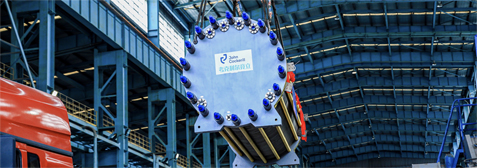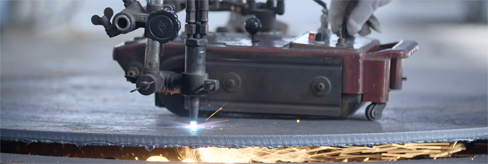“It's really about creating those partnerships and being able and willing to share the risks among the different stakeholders in a project. And we believe that this is really critical to launch the industry at scale.” – Nicolas de Coignac
Executive Vice President of the Group, in charge of global Hydrogen activities and the Americas in the US for John Cockerill, Nicolas de Coignac, met with Nadim Chaudhry ahead of his keynote address at World Hydrogen North America to explore the hydrogen industry's current landscape, addressing its challenges and opportunities. Watch the full video or read the transcript below:
World Hydrogen Leaders Expert Interview: Nicolas de Coignac, John Cockerill
Transcript
NADIM:
[Nicolas], could you give us a little bit of your overview around your view on hydrogen and some of the work that John Cockerill is doing?
NICOLAS:
With pleasure. Thanks for this opportunity. So, you know, for me, I'm discovering, I've been in the hydrogen business at John Cockerill for a little bit more than a year and a half, and coming from the other side of the fence, from the oil and gas business prior to this. And what is amazing in this hydrogen world is how much activity there is in a technology and a world that is pretty well known. I'm not talking about gray hydrogen, but more about green hydrogen. There is so much happening right now. We went from a period of great enthusiasm until a few months ago to a period right now of skepticism and doubt. And I think both are exaggerated. We all know that the path and growth potential for hydrogen is absolutely amazing.
It's one of the most promising energy carriers for the foreseeable future. So what I see today is probably a business that is largely immature. A lot of things have to be designed. We are lacking norms and standards. Technologies are evolving, usages are evolving. We're also discovering potential new ones. Regulation is currently changing, so it's a lot of moving parts, a lot of opportunities to capture. And I think what's difficult today is that there have been a lot of projects that were contemplated, but very few of them have reached the final investment decision today.
There are a lot of players that are able to bring technologies at different stages of readiness. And so what we see today is that we have to prime the pump of those large projects just to establish our industry. And we are still in this period of lacking decisions.
Everyone is looking at what are the right decisions to be made and what are the right projects to be launched.
NADIM:
What are your thoughts around risk? Is there enough appetite to shoulder that risk? Or how do we mitigate risk in the industry and get more projects across the FID line?
NICOLAS:
Well, that's an excellent question. And you know, I think that all those nascent industries at the scales we're contemplating, because here it's not about putting a couple of electrolyzers somewhere; we're creating a brand new industry with a scale that is gigantic and we have to create the right supply chain, we have to create the right partnerships. We're currently working on this. We have already announced partnerships with Technip Energies, creating a joint venture, we will announce others pretty soon. And this is all means to reduce the risks for the whole project. But we are confronted by those risks because the way we intend to use those electrolyzers in the future is significantly different from what we've been doing for decades. You know, as far as John Cockerill is concerned, we have been producing electrolyzers for nearly 30 years.
We have delivered over 1,300 of those electrolyzers that are currently running, facing challenges. And we learn every day from those challenges. And it's because we're using them in new environments with more renewable energy, meaning more intermittency. So the systems themselves are more challenged and we discover new ways of overcoming, let's say, those new usages. So about risk, back to your point.
It's really about creating those partnerships and being able and willing to share the risks among the different stakeholders in a project. And we believe that this is really critical to launch the industry at scale.
We can do this with selected projects anyhow. We cannot have too many of those projects at one time. The capacity is not there, and not specifically for us, but for the whole industry.
So it's about taking the right risk with the right players, and I hear this a lot, “how bankable is your company? You know, what kind of guarantees, performance guarantees do you offer?” My point is that we offer those guarantees. For centuries, we have been building nuclear power plants, steel plants, gas analyzing lines, all those critical pieces of equipment where you have to stand behind your equipment, but beyond that, liquidated damages or whatever financial guarantee that you can give.
If you have a guarantee, a financial guarantee, it's good. But your equipment, if it's not running, it's not running. So you have to choose the partners that are able to overcome the situation and make your hydrogen production plant work, whatever it takes. And this is something that only very few suppliers can do for electrolyzers. So it's all about partnering with the right people to prime the pump of this large-scale industry.
NADIM:
And in terms of taking risks and supply chain, that's something that John Cockerill is doing with your investment in building the gigafactory, in terms of the considerable investment that you're putting in. Yeah, can you tell us a little bit about that?
NICOLAS:
Yeah, well, again, a great question. So, first, as you did mention, we officially have not broken ground, but we had a ribbon cutting of our new plant in the US, in Texas back in November. And I say not groundbreaking because it's a brownfield. So we bought land that already had all the bones, it has the buildings, it has the cranes, it has the infrastructure, it has the railway that comes directly on our site, access to the barge. So our plant is ready. We're currently ordering the equipment to have the plant up and running by late this year, early next year. So we'll be able to have our first electrolyzer go through the gate early next year. But the fact is that we're also leveraging our sister companies. We are commissioning a plant currently in France and in Belgium. We're breaking ground in India for another gigafactory.
And we have, of course, our legacy plant in China that is up and running and delivering equipment. So it means that, from day one, we're able to bring some of the components from those different plants and make sure it's also part of de-risking a project, and be able to start producing, manufacturing and assembling in our plant in the US, in Texas.
We're in parallel to this, making a huge effort in creating a network of suppliers for many of the key and critical components out of North America. There, too, finding the right partnerships with people that do have either existing capacity for some of the components—it can be pieces of steel, engineered membranes, electrodes, power components, whatever it is.
And with them engage early enough so that they have the scale of capacity that matches the ambition of our gigafactory in the US. And this is also a program where you have to have partnership also, not only with your customers, but also with your suppliers.
NADIM:
The projects that are going forward now are going to be the good quality projects with the good quality companies involved who are taking it seriously and building those projects. Is that how you see it?
NICOLAS:
Yeah, you're absolutely right. I think that now if I focus a little bit more specifically on the United States, the IRA, a year and a half ago, or nearly two years ago, created a lot of momentum. And everyone that had a project around renewable energy says, oh, that's also an opportunity to invest into green hydrogen and things like this had hundreds of projects nearly, with no need to do any kind of marketing. Our sales team were flooded with requests for quotations, which was way too much because anyhow, the industry could not afford building so much capacity at once.
Then came the guidance from the IRS about how the IRA will apply. And then this came like a cold shower for everyone, and screened the number of projects, which is good, because then you go on to the stronger, more robust projects. So that's the first screening. And then comes ‘who are the players that are ready to put some risk into this?’ and we're happy to partner in risk-taking. And what we're seeing also is that a lot of the projects that were gigawatts or 600 MW or whatever, now, usually the promoters or the developers are saying, ‘let's go with the first tranche of 100 or 200 megawatts or sometimes a bit less, and let's ramp up and scale it from there.’ And I think this is extremely reasonable. There's a lot of wisdom behind this.
I think this will help, back to my point on supply chain, this will help prime the pump, building the right capacity at the right place, and selecting the best players who are nimble enough, agile enough to be able to resize their project and be able to take it to the next level of ambition once the pump is primed.
NADIM:
In terms of your specific approach, you're building most of your electrolyzers, as I understand it, around a five-megawatt platform, is that correct? You see that as a sweet spot?
NICOLAS:
Yes, that's correct. We've also been testing grounds, and the fact that we are in the business for more than 30 years helped us. We have a wide array of sizes of electrolyzers that range from 100 kilowatts to 6.5 megawatts. And what specifically we are targeting, as John Cockerill, are more utility scale or industry scale hydrogen plants. There are a lot of other needs for smaller scale, you know, five megawatts, ten megawatts. And this is probably where other technologies are maybe best suited. We're targeting the large ones. And for those large ones, yes, we are convinced, and this is not only us, it's by listening to our customers, to the engineering firms and many of the large projects in the world, that five megawatts, pressurized alkaline, among the different technologies, but pressurized alkaline, five megawatts, 15 bars, is probably the sweet spot.
And so this is where we have our current offering. So that's the minimum or the one stack, one electrolyzer. But then we can offer systems where you will have a package of either one stack with all its balance of plant. So the power supply, the separation unit, and the purification, or buy a system of four electrolyzers, meaning 20 megawatts, or six, meaning 30 megawatts. Typically for North America, we're offering a system of 30 megawatts where we have one joint separation unit for six electrolyzers.
NADIM:
Well, that's very clear. As I mentioned, you're going to be speaking at World Hydrogen North America next week in Houston, and we thank you for your support of the event. It's great working with the John Cockerill team and we look forward to seeing your projects rise with success and seeing you help build the industry. Thanks, Nicolas, for taking the time out of your schedule today to share your thoughts with us.












